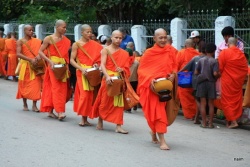Vassa
Vassa (from Pāli vasso, Sanskrit varṣaḥ, both "rain"; Burmese: ဝါတွင်း, wàdwíɴ; Khmer: វស្សា or ពរះវស្សា; Lao: ພັນສາ pʰán sǎː, sometimes ວັດສາ wāt sǎː; Thai: พรรษา, phansaa) is the three-month annual retreat observed by Theravada practitioners. Taking place during the rainy season, Vassa lasts for three lunar months, usually from July (the Burmese month of Waso, ဝါဆို) to October (the Burmese month of Thadingyut သီတင်းကျွတ်).
In English, Vassa is often glossed as Rains Retreat or Buddhist Lent, the latter by analogy to the Christian Lent (which Vassa predates by at least five centuries).
For the duration of Vassa, Bhikkhus remain inside monasteries and temple grounds. In some monasteries, monks dedicate the Vassa to intensive meditation. Some Buddhist lay people choose to observe Vassa by adopting more ascetic practices, such as giving up meat, alcohol, or smoking. While Vassa is sometimes casually called "Buddhist Lent", others object to this terminology.
Vassa is followed by Kathina, a festival in which the laity expresses gratitude to monks. Lay Buddhists bring donations to temples, especially new robes for the monks.
The Vassa tradition pre-dates the time of the historical Buddha. It was a long-standing custom for mendicant ascetics in India not to travel during the rainy season as they may unintentionally harm crops, insects or even themselves during their travels.
Many Buddhist ascetics live in regions which lack a rainy season. Consequently, there are places where Vassa may not be typically observed.
vassa, ( Pali: “rains”) the Buddhist monastic retreat observed primarily in Buddhist communities in Southeast Asia during the three-month monsoon period each year.
The tradition that monks—who ordinarily would be mendicant wanderers—gather in monasteries during the rainy season for a time of study and religious discourse may derive from the ancient custom among South Asian ascetics of retreating to a forest grove, usually near a village, during the monsoon when travel was difficult. Residing in their retreat during the rains, they continued to pursue their meditative quest and begged alms from local townspeople. The practice was well known in India by the time of the Buddha (6th century bce), who, after his enlightenment, is said to have spent the rainy season in a sheltered spot in the forest near Banaras (Varanasi).
The Buddha’s followers assumed the same practice and after his death continued to gather during the monsoon to recite the rules of Buddhist discipline and to reaffirm their commitment to the Buddha’s vision of dharma. As the monastic community (the sangha) became wealthier by virtue of larger and more frequent contributions from the laity, more permanent centres, or viharas, were constructed to house the members of the monastic groups during their annual retreats. With the ascendency of the powerful Mauryan king Ashoka (3rd century bce), who admired and followed the Buddha’s teachings, these viharas flourished throughout northeast India. The viharas are the institutional precursors of both the great Buddhist monastic centres, or Mahaviharas, of South and Southeast Asia and of the custom of the annual religious retreat still practiced in Theravada Buddhist countries today. The vassa has been largely forgotten by Mahayana Buddhists, especially those in China and Japan.
In Thailand, where all Buddhist males customarily spend some time in a monastery, vassa is a favoured period for temporarily experiencing the life of a monk. Seniority as a monk is commonly measured by the number of vassa seasons spent in a monastery.
Vassa begins on the first day of the waning moon of the eighth lunar month (usually in July) and ends on the full moon of the eleventh month (usually October). Vassa concludes with the pavarana ceremony, in which every monk, irrespective of rank or seniority, agrees willingly to receive instruction from any other monk in the monastery if he acts improperly. The lively kathina (“cloth”) ceremony, in which groups of laymen present gifts to the monks, takes place during the first month following the conclusion of vassa.
